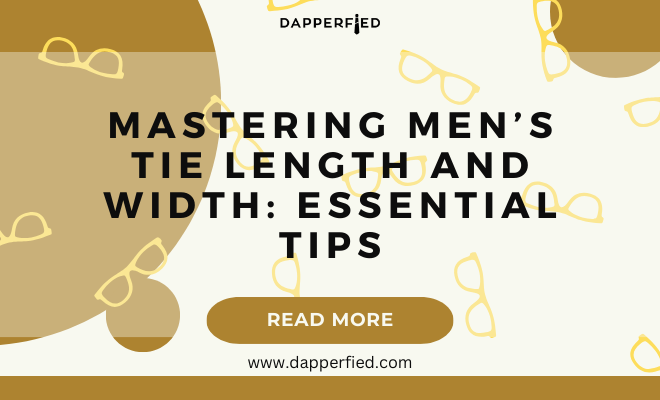
Men's Style
Mastering Men’s Tie Length and Width: Essential Tips
When it comes to choosing the right tie, understanding the basics of tie length and width is essential. The length of a tie is typically around 57 to 58 inches, but can vary depending on the brand and style. The width of a tie is usually around 3 to 3.75 inches, with slimmer ties being more fashionable in recent years. The length and width of a tie can greatly impact the overall look and feel of an outfit, so it’s important to consider these factors when selecting a tie for any occasion.
The length of a tie is crucial for achieving a polished and professional look. A tie that is too short can make you appear sloppy, while a tie that is too long can look awkward and unflattering. It’s important to find the right balance and ensure that the tip of the tie reaches the middle of your belt buckle. The width of a tie also plays a significant role in the overall aesthetic. A wider tie can create a more traditional and conservative look, while a slimmer tie can give off a more modern and stylish vibe. Understanding the basics of tie length and width is the first step in finding the perfect tie for any outfit.
Key Takeaways
- The standard tie length is around 57-58 inches, and the width should be proportionate to the lapel width of your suit jacket.
- For taller individuals, opt for longer ties, while shorter individuals should choose shorter ties to maintain proper proportions.
- The width of your tie should complement the width of your suit lapels, with slim ties for narrow lapels and wider ties for broader lapels.
- When matching tie length and width to your suit and shirt, ensure that the tie reaches the middle of your belt buckle and the tip of the tie touches the top of the belt.
- Adjust tie length and width based on the knot you choose, with larger knots requiring more length and thicker ties for a balanced look.
Finding the Right Length for Your Body Type
Finding the right length for your tie is essential for achieving a polished and put-together look. For taller individuals, a longer tie is necessary to ensure that it reaches the appropriate length. On the other hand, shorter individuals may need to opt for a shorter tie to avoid looking overwhelmed by excess fabric. It’s important to consider your body type when selecting the length of your tie to ensure that it complements your proportions and creates a balanced look.
For taller individuals, a tie length of around 58 inches is typically ideal, as it allows for enough length to reach the appropriate point without looking too short. For shorter individuals, a tie length of around 54 inches may be more suitable to avoid excess fabric hanging below the belt line. It’s important to take your body type into consideration when choosing the length of your tie to ensure that it enhances your overall appearance. By finding the right length for your body type, you can ensure that your tie looks proportionate and polished, no matter the occasion.
Choosing the Appropriate Width for Your Tie
Choosing the appropriate width for your tie is crucial for achieving a stylish and modern look. The width of a tie can greatly impact the overall aesthetic of an outfit, so it’s important to consider this factor when selecting a tie. A wider tie can create a more traditional and conservative look, while a slimmer tie can give off a more modern and stylish vibe. It’s important to choose the appropriate width for your tie to ensure that it complements your outfit and personal style.
For a classic and timeless look, a wider tie with a width of around 3.5 to 3.75 inches is typically ideal. This width is suitable for most body types and can create a polished and professional appearance. On the other hand, for a more modern and fashion-forward look, a slimmer tie with a width of around 2.5 to 3 inches may be more suitable. This width can create a sleek and stylish aesthetic that is perfect for more contemporary outfits. Choosing the appropriate width for your tie is essential for achieving the desired look and ensuring that your outfit appears well-coordinated and put-together.
Matching Tie Length and Width to Your Suit and Shirt
| Aspect | Recommendation |
|---|---|
| Suit Color | Match tie color to the suit color |
| Shirt Color | Contrast tie color with the shirt color |
| Tie Width | Match tie width to the width of the suit lapel |
| Tie Length | Ensure tie length reaches the belt buckle |
Matching tie length and width to your suit and shirt is essential for creating a cohesive and well-coordinated look. When selecting a tie, it’s important to consider the color and pattern of your suit and shirt to ensure that the tie complements the overall outfit. Additionally, the length and width of the tie should be proportionate to the lapels of the suit jacket and the collar of the shirt to create a balanced and polished appearance.
For a classic and timeless look, it’s important to match the width of the tie to the width of the suit lapels. A wider tie is typically more suitable for suits with wider lapels, while a slimmer tie complements suits with narrower lapels. Additionally, the length of the tie should be proportionate to the collar of the shirt, ensuring that it reaches the appropriate point without looking too short or too long. By matching tie length and width to your suit and shirt, you can create a cohesive and well-coordinated outfit that exudes style and sophistication.
Adjusting Tie Length and Width for Different Knots
Adjusting tie length and width for different knots is essential for achieving a polished and put-together look. Different knots require varying amounts of fabric, so it’s important to adjust the length and width of the tie accordingly to ensure that it looks proportionate and well-coordinated. Whether you prefer a classic Windsor knot or a more modern four-in-hand knot, it’s important to consider the impact on tie length and width to achieve the desired look.
For larger knots such as the Windsor or Half-Windsor, a longer tie may be necessary to accommodate the additional fabric required for the knot. On the other hand, for smaller knots such as the four-in-hand, a shorter tie may be more suitable to avoid excess fabric hanging below the knot. Additionally, the width of the tie should also be considered when selecting a knot, as wider ties may not be suitable for smaller knots and vice versa. By adjusting tie length and width for different knots, you can ensure that your tie looks proportionate and well-coordinated, no matter which knot you choose.
Tips for Maintaining the Perfect Tie Length and Width

Maintaining the perfect tie length and width is essential for ensuring that your ties look polished and well-coordinated at all times. To maintain the ideal length, it’s important to store your ties properly by hanging them on a tie rack or rolling them up to avoid creasing or stretching. Additionally, it’s important to untie your ties carefully after each wear to prevent damage to the fabric or altering its length.
To maintain the perfect width of your ties, it’s important to store them properly by hanging them on a tie rack or laying them flat in a drawer to avoid stretching or distorting their shape. Additionally, it’s important to handle your ties with care when tying and untying them to prevent unnecessary wear and tear on the fabric. By following these tips for maintaining the perfect tie length and width, you can ensure that your ties look polished and well-coordinated for any occasion.
Styling Tips for Different Occasions with the Right Tie Length and Width
Styling tips for different occasions with the right tie length and width are essential for creating a well-coordinated and stylish look. For formal events such as weddings or black-tie affairs, it’s important to opt for a classic tie with a standard length and width to create a polished and sophisticated appearance. For more casual events such as cocktail parties or dinner dates, a slimmer tie with a modern width may be more suitable to create a stylish and contemporary look.
When styling ties for professional settings such as business meetings or interviews, it’s important to opt for a classic tie with a standard length and width to create a polished and professional appearance. For more creative or casual work environments, a slimmer tie with a modern width may be more suitable to create a stylish and modern look. By considering these styling tips for different occasions with the right tie length and width, you can ensure that your ties complement your outfit and exude style and sophistication no matter where you go.

In conclusion, understanding the basics of tie length and width is essential for achieving a polished and well-coordinated look. By finding the right length for your body type, choosing the appropriate width for your tie, matching tie length and width to your suit and shirt, adjusting tie length and width for different knots, maintaining the perfect tie length and width, and following styling tips for different occasions with the right tie length and width, you can ensure that your ties complement your outfit and exude style and sophistication no matter where you go.
If you’re looking for more tips on men’s fashion, check out this article on stylish shirts for men from Dapperfied. It offers great advice on finding the perfect shirt to complement your tie and complete your look.
FAQs
What is the standard length of a men’s tie?
The standard length of a men’s tie is around 57 to 58 inches. This length is suitable for most average-sized men and allows for the proper tying of the tie.
What is the standard width of a men’s tie?
The standard width of a men’s tie is around 3 to 3.75 inches. This width is considered to be a classic and versatile option that works well for most body types and suit styles.
How should a tie be worn in relation to the body?
A tie should ideally reach the belt buckle or the waistband of the trousers. It should not be too long or too short, as this can affect the overall appearance and balance of the outfit.
Are there different tie lengths and widths for specific body types?
Yes, there are ties available in different lengths and widths to accommodate different body types. Taller individuals may opt for longer ties, while slimmer or broader individuals may choose narrower or wider ties to complement their proportions.
What are some tips for choosing the right tie length and width?
When choosing a tie, consider your body type, the type of suit you will be wearing, and your personal style. It’s important to find a balance between the tie length and width that complements your overall look and provides a polished appearance.














